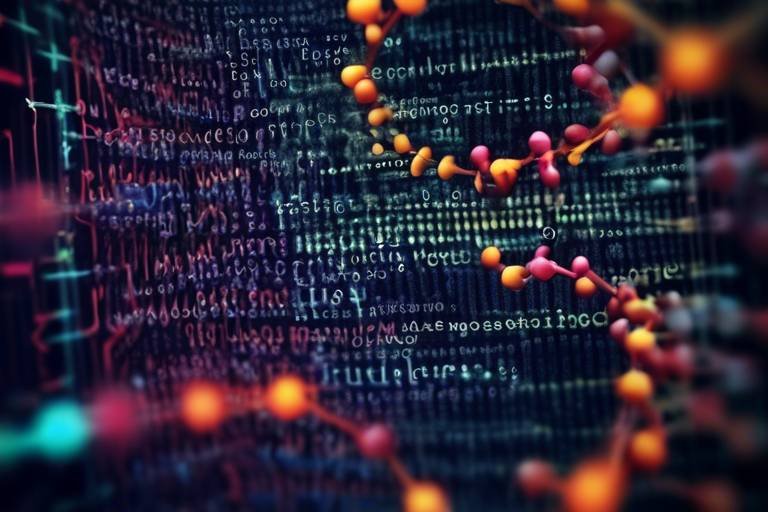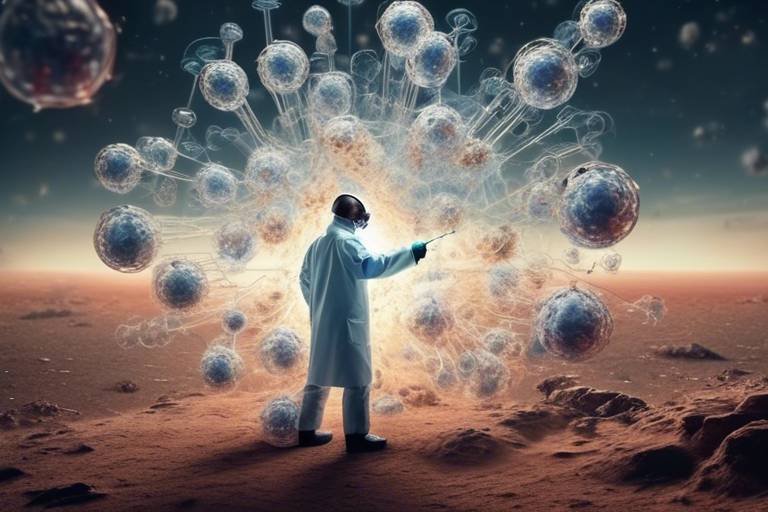How Science is Addressing Global Food Insecurity
In a world where nearly 800 million people go to bed hungry each night, the need for innovative solutions to combat global food insecurity has never been more critical. This challenge is not just about producing more food; it's about doing so in a sustainable way that protects our planet for future generations. Science plays a pivotal role in this endeavor, offering a treasure trove of innovative approaches that are transforming the agricultural landscape. From cutting-edge farming techniques to groundbreaking genetic research, the scientific community is stepping up to ensure that everyone has access to nutritious food.
Imagine a future where food is grown in urban skyscrapers, where crops can thrive without soil, and where every meal is produced with minimal environmental impact. This isn't just a dream—it's happening now! By harnessing the power of technology and nature, scientists are developing methods that not only increase food production but also enhance the quality of what we eat. This article will delve into the various scientific strategies being employed to tackle food insecurity, highlighting the importance of sustainability, collaboration, and innovation.
As we explore these solutions, it's essential to recognize that food insecurity is a complex issue influenced by a myriad of factors, including climate change, economic instability, and social inequalities. Therefore, the answers must be multifaceted, combining the best of science and community efforts. Let's dive into the exciting world of scientific advancements that are shaping the future of food security.

Innovative Agricultural Techniques
In the quest to tackle global food insecurity, innovative agricultural techniques are paving the way for a brighter and more sustainable future. These methods are not just about increasing crop yields; they're about revolutionizing the entire farming landscape. Imagine a world where food is grown in urban centers, where every square foot of land is utilized to its fullest potential. This is the promise of vertical farming, a method that stacks crops in layers, allowing for maximum production in minimal space. By using controlled environments, vertical farms can produce food year-round, independent of weather conditions, and significantly reduce the carbon footprint associated with traditional farming.
Another groundbreaking technique is hydroponics. This soil-less method of growing plants uses nutrient-rich water to nourish crops, making it possible to grow food in areas with poor soil quality. Hydroponics not only conserves water but also allows for faster growth rates and higher yields. In fact, studies have shown that hydroponically grown plants can grow up to 30% faster than their soil-grown counterparts. Additionally, this technique can be implemented in urban settings, transforming rooftops and abandoned buildings into lush gardens that contribute to food security.
Then there's aquaponics, a harmonious blend of aquaculture (raising fish) and hydroponics. In this system, fish waste provides an organic nutrient source for the plants, while the plants help filter and purify the water for the fish. This symbiotic relationship not only maximizes resource efficiency but also creates a sustainable cycle that can produce both fish and vegetables. Imagine being able to harvest fresh fish and greens from your backyard—this is not just a dream but a reality for many who have embraced aquaponics.
These innovative techniques are a response to the challenges posed by urbanization and climate change. As cities expand and arable land diminishes, the need for efficient, sustainable farming practices becomes more critical. Furthermore, these methods require less land and water than traditional agriculture, making them ideal for regions facing severe resource constraints.
Moreover, these techniques are not just about the environment; they also have socioeconomic benefits. By localizing food production, communities can reduce their reliance on long supply chains, which are often vulnerable to disruptions. This means fresher produce, lower transportation costs, and increased food security. Additionally, urban farming initiatives can create jobs and stimulate local economies, turning food deserts into food oases.
In summary, the rise of innovative agricultural techniques such as vertical farming, hydroponics, and aquaponics is transforming the way we think about food production. These methods not only promise to increase yield and efficiency but also contribute to a more sustainable and resilient food system. As we continue to face the challenges of food insecurity, embracing these technologies will be crucial in ensuring that everyone has access to nutritious food. The future of farming is here, and it's more exciting than ever!

Genetically Modified Organisms (GMOs)
Genetically Modified Organisms, commonly known as GMOs, have become a focal point in the conversation surrounding global food security. These organisms are created through modern biotechnology, which allows scientists to introduce specific changes to the genetic makeup of crops, enhancing their ability to thrive in challenging conditions. Imagine being able to give a plant a superhero cape—this is what genetic modification aims to achieve! By altering the DNA of crops, we can make them more resilient to pests, diseases, and extreme weather, which is crucial in a world where climate change is a pressing concern.
One of the most significant advantages of GMOs is their potential to increase agricultural productivity. For instance, genetically modified crops can yield more produce per acre compared to their non-GMO counterparts. This increase in yield is vital for feeding the growing global population, which is projected to reach nearly 10 billion by 2050. In fact, studies have shown that GMO crops can lead to a remarkable increase in yield, helping farmers produce more food with less land. The table below illustrates the comparison of yield between GMO and non-GMO crops:
| Crop Type | Average Yield (tons per hectare) | Year Introduced |
|---|---|---|
| GMO Corn | 10.5 | 1996 |
| Non-GMO Corn | 8.2 | N/A |
| GMO Soybeans | 3.5 | 1996 |
| Non-GMO Soybeans | 2.8 | N/A |
Furthermore, GMOs can be engineered to enhance their nutritional content. For example, scientists have developed Golden Rice, which is fortified with Vitamin A to combat malnutrition in regions where rice is a staple food. This innovation not only helps in addressing food security but also tackles health issues associated with nutrient deficiencies. It's like turning a basic meal into a health-boosting powerhouse!
However, the use of GMOs is not without controversy. Critics often raise concerns regarding biodiversity, potential health risks, and the ethics of altering nature. It's essential to address these concerns through rigorous scientific studies and transparent communication. The truth is, GMOs undergo extensive testing before they reach our plates, ensuring they are safe for consumption. A balanced discussion about GMOs is crucial, as they represent a significant tool in our arsenal against food insecurity.
In summary, GMOs hold tremendous promise for enhancing food security globally. By increasing crop yields, improving nutritional content, and ensuring resilience against environmental challenges, they can play a pivotal role in feeding our growing population. As we look to the future, embracing scientific advancements like GMOs, while also considering ethical and environmental implications, will be key to creating a sustainable food system for all.
Frequently Asked Questions
- What are GMOs? GMOs are organisms whose genetic material has been altered using genetic engineering techniques to introduce desirable traits.
- Are GMOs safe to eat? Yes, GMOs undergo rigorous testing for safety and are deemed safe for consumption by numerous health organizations worldwide.
- How do GMOs help with food security? GMOs can increase crop yields, enhance nutritional content, and provide resilience against pests and climate change, making them crucial for food production.
- What are some examples of GMO crops? Common examples include GMO corn, soybeans, and cotton, which have been modified for various benefits.

Climate-Resilient Crops
In a world increasingly challenged by climate change, the development of has never been more critical. These innovative crops are engineered or bred to withstand the harsh realities of our changing environment, including extreme temperatures, droughts, floods, and pest invasions. Imagine a farmer in a drought-stricken area who can still harvest a bountiful crop due to these resilient varieties. It’s not just a dream; it’s becoming a reality!
Climate-resilient crops are designed to thrive in conditions that would normally spell disaster for traditional varieties. For instance, scientists are working on drought-tolerant maize and flood-resistant rice, which can survive prolonged periods of little or no water, or excess water, respectively. This means that farmers can maintain productivity even in the face of unpredictable weather patterns.
One of the most exciting aspects of climate-resilient crops is their potential to improve food security globally. By ensuring that crops can survive in adverse conditions, we can stabilize food supplies and reduce reliance on imports, which can be affected by international market fluctuations. For example, in regions like Sub-Saharan Africa, where climate variability is a significant challenge, these crops can help farmers produce enough food to feed their communities.
Additionally, the development of these crop varieties often involves advanced genetic techniques, including genome editing technologies like CRISPR. This allows scientists to make precise changes to a plant's DNA, enhancing its ability to withstand environmental stresses without compromising its nutritional value. The result? Crops that not only survive but thrive, providing essential nutrients to populations that need them the most.
To illustrate the impact of climate-resilient crops, consider the following table that compares traditional crops with their resilient counterparts:
| Crop Type | Traditional Variety | Climate-Resilient Variety |
|---|---|---|
| Maize | High water requirement | Drought-tolerant, requires less water |
| Rice | Susceptible to flooding | Flood-resistant, survives submerged conditions |
| Wheat | Vulnerable to heat stress | Heat-tolerant, maintains yield under high temperatures |
Moreover, the benefits of climate-resilient crops extend beyond just survival; they can also help in reducing greenhouse gas emissions. By enabling farmers to produce more food on less land, these crops can help decrease the need for deforestation and land conversion, which are major contributors to climate change. This creates a positive feedback loop where sustainable farming practices not only help combat food insecurity but also contribute to environmental conservation.
However, the adoption of climate-resilient crops is not without challenges. Farmers must be educated about these new varieties, and there needs to be a robust infrastructure in place to support their cultivation and distribution. Governments, NGOs, and private sectors must collaborate to ensure that farmers have access to these vital resources. After all, the goal is not just to create resilient crops but to empower farmers and communities to utilize them effectively.
In summary, climate-resilient crops represent a beacon of hope in the fight against food insecurity exacerbated by climate change. They are not just a scientific achievement; they are a lifeline for farmers and communities around the globe. As we continue to innovate and develop these crops, we move closer to a future where everyone has access to the food they need, regardless of the climate challenges they face.
- What are climate-resilient crops?
These are crops specifically bred or genetically modified to withstand extreme weather conditions, such as droughts and floods. - How do climate-resilient crops help with food security?
By maintaining yields in adverse conditions, they ensure stable food supplies and reduce reliance on imports. - What technologies are used to develop these crops?
Advanced genetic techniques, including genome editing technologies like CRISPR, are utilized to enhance crop resilience. - Are there any challenges in adopting climate-resilient crops?
Yes, challenges include the need for farmer education and infrastructure to support cultivation and distribution.

Food Waste Reduction Strategies
Food waste is a colossal issue that plagues our global food system. It's estimated that about one-third of all food produced for human consumption is wasted each year. This not only represents a staggering loss of resources but also contributes significantly to environmental degradation. So, how can we tackle this challenge? By implementing innovative that span the entire supply chain—from farm to fork.
One of the most effective approaches is enhancing food recovery networks. These networks connect food businesses, such as restaurants and grocery stores, with local charities and food banks. By redistributing surplus food that would otherwise go to waste, we can help feed those in need while minimizing waste. This collaborative effort not only addresses hunger but also reduces the environmental impact associated with food disposal.
Another promising strategy involves employing technology to track and manage food inventory more efficiently. For instance, smart inventory management systems can help retailers and restaurants monitor their stock levels in real-time, reducing over-ordering and spoilage. Additionally, apps that connect consumers with local markets selling discounted items nearing their expiration date are gaining popularity. These platforms not only save consumers money but also ensure that food is consumed rather than wasted.
Furthermore, educational initiatives play a pivotal role in reducing food waste at the consumer level. By teaching individuals about proper food storage techniques and creative ways to use leftovers, we can significantly cut down on waste at home. For example, many people are unaware that fruits and vegetables can often be preserved or repurposed into delicious dishes. Simple education can empower consumers to make smarter choices, ultimately leading to less food waste.
In addition, businesses are increasingly adopting sustainable packaging solutions that help extend the shelf life of products. Innovations in biodegradable materials and vacuum-sealed packaging can keep food fresher for longer, reducing spoilage during transport and storage. A recent study showed that using modified atmosphere packaging can reduce spoilage by up to 30%, highlighting the importance of investing in such technologies.
To illustrate the impact of these strategies, consider the following table that outlines the potential benefits of implementing food waste reduction initiatives:
| Strategy | Potential Benefits |
|---|---|
| Food Recovery Networks | Reduces hunger, minimizes waste, and fosters community collaboration. |
| Technology Integration | Improves inventory management, reduces over-ordering, and connects consumers with discounts. |
| Educational Initiatives | Empowers consumers to reduce waste, enhances food preservation knowledge. |
| Sustainable Packaging | Extends shelf life, reduces spoilage, and promotes eco-friendly practices. |
Ultimately, addressing food waste requires a multifaceted approach that combines technology, education, and community engagement. By fostering partnerships among businesses, governments, and consumers, we can create a more sustainable food system. The journey towards reducing food waste is not just about saving money; it’s about preserving our planet and ensuring that everyone has access to the food they need.
- What are some common causes of food waste? Food waste often occurs due to overproduction, poor inventory management, and lack of consumer awareness about food preservation.
- How can individuals reduce food waste at home? Individuals can reduce food waste by planning meals, properly storing food, and creatively using leftovers.
- What role do businesses play in reducing food waste? Businesses can implement better inventory management practices, donate surplus food, and adopt sustainable packaging solutions.
- Are there any technologies that can help with food waste reduction? Yes, technologies such as smart inventory systems and food waste tracking apps can significantly help reduce waste.

Precision Agriculture
Precision agriculture is a game-changer in the world of farming, revolutionizing the way we think about food production. Imagine a world where farmers can pinpoint the exact needs of their crops, applying water, fertilizers, and pesticides with surgical precision. This isn’t just a dream—it’s happening right now, thanks to advancements in technology. By leveraging data analytics, satellite imagery, and the Internet of Things (IoT), farmers are now able to monitor and manage their fields like never before. This approach not only maximizes yield but also minimizes waste, making it a crucial component in the fight against food insecurity.
The core idea behind precision agriculture is to use data-driven insights to make informed decisions. For instance, by using satellite imagery, farmers can analyze soil health and moisture levels across different sections of their fields. This allows them to determine precisely where to plant, irrigate, and fertilize. In fact, studies have shown that precision agriculture can lead to yield increases of up to 20% while reducing input costs significantly. It’s like having a personal trainer for your crops—helping them reach their full potential!
One of the most exciting aspects of precision agriculture is its ability to reduce environmental impact. By applying resources more efficiently, farmers can cut down on excess water usage and chemical runoff, which are major contributors to environmental degradation. For example, a recent study highlighted that farms employing precision irrigation techniques were able to reduce water consumption by over 30%. This not only conserves precious water resources but also protects local ecosystems from harmful runoff.
Furthermore, precision agriculture is paving the way for sustainable farming practices. Through technologies such as drone surveillance and soil sensors, farmers can gather real-time data on crop health and soil conditions. This information enables them to implement targeted interventions, reducing the need for blanket applications of fertilizers and pesticides. In essence, it’s about working smarter, not harder, and ensuring that every drop of water and every grain of fertilizer is used efficiently.
To illustrate the impact of precision agriculture, consider the following table that outlines some key technologies and their benefits:
| Technology | Benefits |
|---|---|
| GPS Technology | Allows for accurate field mapping and soil analysis. |
| Drones | Provides aerial imagery for crop monitoring and health assessment. |
| Soil Sensors | Measures moisture and nutrient levels for targeted irrigation and fertilization. |
| Data Analytics | Helps in predicting crop yields and optimizing resource allocation. |
As we look to the future, the potential of precision agriculture is boundless. With ongoing advancements in technology, we can expect even greater efficiencies and innovations in farming practices. Imagine a future where farmers can predict weather patterns with pinpoint accuracy, allowing them to plan their planting and harvesting schedules accordingly. Or envision a scenario where every farm is equipped with smart sensors that communicate in real-time, sharing data across regions to enhance food production globally.
In conclusion, precision agriculture is not just a trend; it’s a necessity in our quest to combat food insecurity. By harnessing the power of technology, we can create a more sustainable and efficient food system that meets the needs of a growing population. So, the next time you enjoy a meal, remember that behind every bite is a world of innovation working tirelessly to ensure that food is not only available but also produced responsibly.
- What is precision agriculture? Precision agriculture is a farming management concept that uses technology to monitor and manage field variability in crops to optimize yield and resource use.
- How does precision agriculture benefit the environment? It reduces waste, conserves water, and minimizes the use of chemicals, leading to a lower environmental impact.
- What technologies are involved in precision agriculture? Technologies include GPS, drones, soil sensors, and data analytics.
- Can precision agriculture increase crop yields? Yes, studies have shown that it can lead to yield increases of up to 20%.

Sustainable Aquaculture
Sustainable aquaculture is becoming a game-changer in our quest to meet the ever-growing demand for seafood while preserving the delicate balance of our ecosystems. Imagine a world where fish farming not only provides a reliable source of protein but also supports the health of our oceans and rivers. This is the vision that sustainable aquaculture aims to achieve. By implementing responsible practices, aquaculture can provide a steady supply of fish without depleting wild stocks or causing significant environmental harm.
One of the key principles of sustainable aquaculture is the focus on environmental stewardship. This involves managing fish farms in a way that minimizes pollution, reduces habitat destruction, and conserves water resources. For instance, many modern fish farms are designed to recycle water and nutrients, which significantly lowers the ecological footprint of fish production. Techniques such as integrated multi-trophic aquaculture (IMTA) are also gaining traction, where different species are farmed together. This approach not only maximizes space but also enhances nutrient cycling, as waste from one species becomes food for another.
Moreover, sustainable aquaculture emphasizes the use of alternative feed sources. Traditional fish feeds often rely on wild-caught fish, which puts additional pressure on marine ecosystems. However, innovative solutions are emerging, such as using plant-based proteins and by-products from other industries. This shift not only reduces the dependency on wild fish but also opens up new avenues for sustainable feed production. For example, some companies are exploring insect protein as a viable alternative, which could revolutionize the feed industry.
In addition to environmental considerations, sustainable aquaculture also addresses social responsibility. It aims to support local communities by providing jobs and promoting fair labor practices. By engaging local populations in aquaculture projects, we can empower them to take control of their food sources and improve their livelihoods. This community-based approach fosters a sense of ownership and responsibility towards sustainable practices, ensuring that the benefits of aquaculture are shared equitably.
To illustrate the impact of sustainable aquaculture, consider the following table that highlights some successful examples from around the globe:
| Country | Practice | Impact |
|---|---|---|
| Norway | IMTA systems with salmon and seaweed | Reduced waste and enhanced biodiversity |
| Bangladesh | Community-managed shrimp farming | Improved livelihoods and sustainable practices |
| USA | Recirculating aquaculture systems (RAS) | Water conservation and reduced environmental impact |
As we look to the future, the importance of sustainable aquaculture cannot be overstated. With the global population projected to reach nearly 10 billion by 2050, the demand for seafood is expected to soar. By prioritizing sustainable practices, we can ensure that aquaculture contributes positively to food security while safeguarding our environment. The journey towards sustainable aquaculture is not without its challenges, but through innovation, collaboration, and a commitment to responsible practices, we can make significant strides in creating a more sustainable food system.
- What is sustainable aquaculture? Sustainable aquaculture refers to fish farming practices that prioritize environmental health, social responsibility, and economic viability.
- How does sustainable aquaculture benefit the environment? It minimizes pollution, conserves water resources, and promotes biodiversity through practices like integrated multi-trophic aquaculture.
- What are alternative feed sources in aquaculture? Alternative feed sources include plant-based proteins and insect protein, which reduce reliance on wild fish.
- Can sustainable aquaculture support local communities? Yes, by providing jobs and encouraging community involvement, sustainable aquaculture can improve livelihoods and empower local populations.

Community-Based Solutions
When it comes to tackling the pressing issue of food insecurity, community-based solutions are like a breath of fresh air. They tap into the power of local knowledge and resources, empowering individuals and families to take charge of their food systems. Imagine a neighborhood where everyone works together, sharing skills and resources to create a sustainable food network—sounds like a dream, right? But this is becoming a reality in many places around the globe.
One of the most effective strategies is the establishment of community gardens. These green spaces not only provide fresh produce but also foster a sense of community and belonging. Residents come together to plant, cultivate, and harvest, learning about sustainable practices along the way. This hands-on experience cultivates not just crops, but also knowledge about nutrition and food preparation, ultimately leading to healthier lifestyles.
Moreover, community-supported agriculture (CSA) programs have gained traction. In these initiatives, local farmers partner with community members, who subscribe to receive a share of the harvest. This model strengthens the bond between producers and consumers, ensuring that local farms thrive while providing fresh, seasonal food directly to the community. It’s a win-win situation! Not only does this reduce food miles, but it also allows people to reconnect with the origins of their food.
Another innovative approach is the implementation of food cooperatives. These cooperatives are owned and operated by community members, providing access to affordable, healthy food options. By pooling resources, members can purchase in bulk, reducing costs and ensuring that everyone has access to nutritious food. This model not only addresses food insecurity but also promotes economic sustainability within the community.
Education plays a crucial role in these community-driven initiatives. Workshops on gardening, cooking, and nutrition empower individuals with the knowledge they need to make informed food choices. For instance, teaching families how to grow their own vegetables can significantly reduce their reliance on store-bought produce, which often comes with a hefty price tag. The ripple effect of such education can lead to a healthier community overall, as people become more aware of what they eat and how it impacts their well-being.
In addition to these grassroots efforts, collaboration with local organizations and governments can amplify the impact of community-based solutions. By forming partnerships, communities can access resources, funding, and expertise that can help scale their initiatives. For example, local nonprofits can provide training and support for community gardens, while government programs can offer grants to help establish food cooperatives.
Ultimately, community-based solutions are about more than just food; they are about building resilient communities. They create social connections, enhance local economies, and promote sustainability. By harnessing the collective power of individuals, neighborhoods can address food insecurity in a way that is tailored to their unique needs and circumstances. So, the next time you think about food security, remember that sometimes the best solutions come from within the community itself.
- What are community gardens? Community gardens are shared spaces where residents can grow fruits, vegetables, and flowers together, fostering community spirit and providing access to fresh produce.
- How do community-supported agriculture (CSA) programs work? In CSA programs, members subscribe to receive a portion of the harvest from local farmers, ensuring fresh, seasonal produce while supporting local agriculture.
- What role does education play in community-based food solutions? Education empowers community members with knowledge about gardening, cooking, and nutrition, helping them make informed food choices and promoting healthier lifestyles.

Global Partnerships and Collaborations
In the quest to tackle global food insecurity, one of the most crucial elements is the formation of strong partnerships across various sectors. Governments, non-governmental organizations (NGOs), and private companies are coming together like never before, pooling their resources and knowledge to create innovative solutions that can make a real difference. Just imagine a world where everyone has access to nutritious food – that’s the goal these collaborations aim to achieve!
These partnerships often take the form of multi-stakeholder initiatives, where diverse groups unite to address common challenges. For instance, organizations like the United Nations Food and Agriculture Organization (FAO) and various international NGOs work hand-in-hand with local communities to implement sustainable agricultural practices. This approach not only enhances food production but also empowers local farmers by providing them with the tools and knowledge they need to succeed.
Moreover, the role of technology in these collaborations cannot be overstated. With the advent of digital platforms and data-sharing tools, stakeholders can now communicate and coordinate their efforts more effectively. For example, platforms like AgFunder and Farmers Edge are revolutionizing how agricultural data is shared, enabling farmers to make informed decisions about crop management and resource allocation. This kind of collaboration enhances productivity and minimizes waste, which is essential in the fight against food insecurity.
Another significant aspect of these global partnerships is the emphasis on research and development. Collaborative research initiatives are essential for developing new technologies and practices that can enhance food security. For instance, the Crop Trust works with various research institutions to conserve crop diversity and develop resilient varieties that can withstand climate change. This kind of research is vital for ensuring that we have a diverse food supply that can adapt to changing conditions.
Let’s not forget about the importance of funding in these partnerships. Financial support from international organizations, philanthropic foundations, and private investors is crucial for scaling up successful initiatives. For example, the Global Agriculture and Food Security Program (GAFSP) provides funding to projects that aim to improve food security in developing countries. This financial backing allows local organizations to implement sustainable practices that generate long-term benefits for their communities.
In summary, the fight against food insecurity is not a solo endeavor; it requires a symphony of efforts from various sectors working in harmony. Through global partnerships and collaborations, we can leverage collective knowledge and resources to create sustainable solutions that ensure food availability for all. This is not just an idealistic vision; it is a necessary step towards a more secure and equitable world.
- What are global partnerships in food security? Global partnerships in food security refer to collaborations between governments, NGOs, and private sectors aimed at addressing food insecurity through shared resources and expertise.
- Why are collaborations important? Collaborations are essential as they combine diverse knowledge and resources, enabling more effective solutions to be developed and implemented.
- How can technology aid in food security collaborations? Technology facilitates better communication, data sharing, and the implementation of innovative agricultural practices, which can enhance productivity and sustainability.
- What role does funding play in these partnerships? Funding is crucial for scaling successful initiatives and implementing sustainable practices that can improve food security in vulnerable communities.

Future Trends in Food Security
As we look towards the horizon of food security, it's clear that innovation is not just a possibility; it's a necessity. With the world's population expected to reach nearly 10 billion by 2050, the demand for food will soar to unprecedented levels. So, what does the future hold? Let’s dive into some of the most exciting trends that are shaping the landscape of food security.
One of the most talked-about advancements is lab-grown meat. Imagine biting into a juicy burger that didn't come from a farm but was instead cultivated in a lab. This revolutionary approach not only has the potential to meet the growing meat demand but also significantly reduces the environmental impact associated with traditional livestock farming. By eliminating the need for large-scale animal husbandry, lab-grown meat offers a sustainable alternative that could help reduce greenhouse gas emissions, conserve water, and minimize land use.
Another trend gaining momentum is the rise of alternative protein sources. From insect farming to plant-based proteins, these options are becoming more mainstream. For instance, companies are now creating protein-rich snacks made from crickets and other insects, which are not only nutritious but also require far less land and water than traditional livestock. This shift towards alternative proteins could be a game-changer in addressing global hunger while also catering to the growing demand for sustainable food sources.
Moreover, advancements in agricultural biotechnology are paving the way for crops that are not only more resilient but also more nutritious. Scientists are working on biofortification, a process that enhances the nutritional content of staple crops. For instance, rice enriched with vitamins and minerals could play a pivotal role in combating malnutrition in developing regions. This kind of innovation can transform the way we think about food production and health.
To give you a clearer picture of these trends, here’s a
| Trend | Description | Potential Impact |
|---|---|---|
| Lab-Grown Meat | Meat produced from cultured cells in a lab. | Reduces environmental footprint and animal welfare concerns. |
| Alternative Proteins | Protein sources from insects and plant-based origins. | Diverse food options, lower resource usage. |
| Agricultural Biotechnology | Genetic modification to enhance crop resilience and nutrition. | Improved food security and health outcomes. |
Additionally, the integration of smart technology in agriculture is set to revolutionize food production. With the advent of the Internet of Things (IoT), farmers can now monitor crop health, soil conditions, and weather patterns in real-time. This data-driven approach allows for precision farming, where resources are used more efficiently, leading to higher yields and less waste. Imagine a farmer receiving alerts on their smartphone about when to irrigate or fertilize their crops, ensuring optimal growth conditions.
Finally, the importance of community engagement cannot be overstated. As we look to the future, empowering local communities to take charge of their food systems is essential. Grassroots initiatives that promote sustainable practices and local food production can create resilient food systems that are less dependent on global supply chains. This not only enhances food security but also strengthens community bonds and fosters a sense of ownership over food resources.
In conclusion, the future of food security is bright, filled with opportunities for innovation and collaboration. As we embrace these trends, we must remain committed to sustainability and inclusivity, ensuring that everyone has access to safe, nutritious food. After all, food security is not just about quantity; it's about quality and equity.
- What is lab-grown meat? Lab-grown meat is produced by culturing animal cells in a lab, offering a sustainable alternative to traditional meat.
- How do alternative protein sources help with food security? Alternative proteins, such as insects and plant-based options, require fewer resources to produce and can help meet the growing demand for food.
- What role does technology play in agriculture? Technology, especially IoT, allows farmers to optimize their practices through real-time data, leading to higher efficiency and reduced waste.
- Why is community engagement important in food security? Engaging local communities empowers them to address their specific food needs and promotes sustainable practices tailored to their context.
Frequently Asked Questions
- What are innovative agricultural techniques, and how do they help food security?
Innovative agricultural techniques like vertical farming, hydroponics, and aquaponics are revolutionizing food production. These methods allow for higher crop yields in smaller spaces, which is crucial in urban areas where land is limited. By minimizing the environmental impact, these techniques not only boost food availability but also promote sustainability.
- How do genetically modified organisms (GMOs) contribute to food security?
GMOs are engineered to enhance crop resilience against pests and diseases, improve nutritional content, and increase overall production efficiency. By creating crops that can thrive in less-than-ideal conditions, GMOs play a vital role in ensuring stable food supplies, especially in regions facing agricultural challenges.
- What are climate-resilient crops, and why are they important?
Climate-resilient crops are specially developed to withstand extreme weather conditions, such as droughts and floods. These crops are crucial in the fight against food insecurity as they ensure that farmers can produce food even in the face of climate change, thereby stabilizing food supplies.
- What strategies are being used to reduce food waste?
Food waste reduction strategies include optimizing the supply chain, improving storage techniques, and educating consumers about food preservation. By addressing waste at every stage—from production to consumption—we can significantly improve food availability and contribute to a more sustainable food system.
- How does precision agriculture enhance farming efficiency?
Precision agriculture utilizes data analytics, satellite imagery, and IoT technologies to optimize resource use. This targeted approach allows farmers to apply water, fertilizers, and pesticides more effectively, leading to increased yields and reduced environmental impact.
- What is sustainable aquaculture, and why is it necessary?
Sustainable aquaculture focuses on responsible fish farming practices that meet the growing demand for seafood while minimizing ecological damage. This approach ensures that fish populations remain healthy and ecosystems are preserved, making it a key component of global food security.
- How can community-based solutions address food insecurity?
Community-based solutions empower local populations by providing education and resources tailored to their specific needs. By fostering collaboration and sustainable practices, these grassroots initiatives can effectively combat food insecurity at the local level.
- Why are global partnerships important in tackling food insecurity?
Global partnerships among governments, NGOs, and private sectors are crucial in addressing food insecurity. By sharing knowledge, resources, and innovative solutions, these collaborations can create a more resilient food system that benefits everyone.
- What future trends are expected to impact food security?
Emerging trends such as lab-grown meat, alternative protein sources, and advancements in agricultural biotechnology are set to shape the future of food security. These innovations promise to provide sustainable food options that can meet the needs of a growing global population.



















